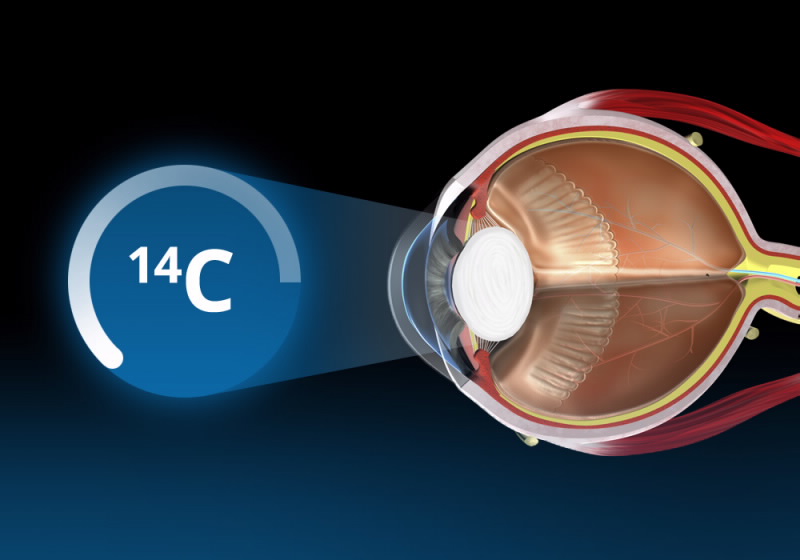Age-related cataract and a reduction in the ability to focus (presbyopia) are very common vision problems in older people. New research from ANSTO has provided evidence to confirm the long life of an important biomolecule in the human eye lens which may be relevant for the study of age-related diseases and conditions.

E-life has recently published a manuscript from a group of researchers from the University of Wollongong, the Illawarra Health and Medical Research Institute, Queensland University of Technology and ANSTO.
Surprisingly, the human eye lens, whose function is to focus light onto the retina, does not lose and replace cells during an entire lifespan, according to co-investigator, research scientist Vladimir Levchenko of the Institute for Environmental Research.
“It is the first time that it has been shown that the molecule, a lipid, without access to metabolic machinery, lives longer than other lipids in the body,” said Levchenko, who collaborated with key investigator, neuroscientist Dr Jennifer Hughes and others on the paper.
Radiocarbon dating
Radiocarbon dating is most well-known for establishing the age of samples, such as sediment, coral or archaeological artefacts, but it can also be used to gain forensic information about biological processes.
Levchenko used accelerated mass spectroscopy (AMS) on the ANTARES accelerator at the Centre for Accelerator Science to measure the amount of a specific isotope, carbon-14, present in the lenses of fourteen donors. He and Hughes extracted lipids from the nucleus of the lens for the analysis.
A measurement of the amount of carbon-14 in a class of molecules allows you to date biosynthesis and the time the system stopped exchanging carbon with its surroundings.
The carbon-14 content of the lens thus reflects the atmospheric content of carbon-14 when the lens crystallines were formed. Precise radiocarbon dating is made possible by comparing the carbon-14 content of the lens crystallines to the so-called bomb pulse.1
The investigators found that the level of carbon-14 in the nucleus of the lenses reflected the amount of carbon-14 in the atmosphere of the year of birth. The donors had birth dates from 1948 to 1993. Because the level of carbon-14 was found to be an accurate predictor of birth, it indicated the absence of lipid turnover during the human lifespan.
| Radiocarbon dating can be used with human tissue because of a development known as the bomb pulse. Between 1955 and 1963 above-ground nuclear testing generated increased concentrations of radioactive carbon-14 in the earth’s atmosphere. After a 1964 moratorium on above ground testing, atmospheric levels of Carbon-14 began falling as the radioactivity passed from the atmosphere into the oceans and the biosphere. Virtually every organism living since the 1950’s is labelled with higher than normal levels of carbon-14, including humans. The rapid year-to-year changes in atmospheric levels of carbon-14 within this time frame, combined with rapid transfer of atmospheric carbon-14 into the food chain through photosynthesis, mean that the distribution of bomb-derived carbon-14 within the humans depends upon birth year, diet, and the dynamics of tissue replacement within the human body. The radiocarbon content of tissues is fixed at the time of death.2 |
Although radiocarbon dating has been used previously to estimate the age of human tissue, these results represent the first evidence that lipids live for a long time.
The lens has a unique pattern of growth in which fibre cells are added to the lens that is present from birth. Newly-formed fibre cells capture and enclose pre-existing cells. This unique pattern of growth may explain the lack of molecular turnover, according to investigators.
Different classes of lipids appear to have relative chemical stability under the conditions experienced within the lens. The lipid, a sphingomyelin, is more abundant than another type of phospholipid in the human lens. Lipids in the core of the nucleus are as old as the lens itself.3
Only humans have a quantity of this lipid in the lens.
The new data correlates with earlier studies that established the content of sphingomyelin remains relatively stable over time.
Lipids are known to be critical to cellular function in the body and, generally, lipid turnover is rapid. A breakdown in lipid regulation has been linked to disease. The new research indicates activity which is counter to this association.
Although it is not known if other long-lived lipids are present in other tissue, the findings may prove to be important in understanding the development of age-related diseases.
1. D Borchman M Yappert J Lipid Res. 2010 Sep; 51(9): 2473–2488 N Lynnerup , H Kjeldsen, S Heegaard, C Jacobsen, J Heinemeier Radiocarbon Dating of the Human Eye
Lens Crystallines Reveal Proteins without Carbon Turnover throughout Life PLOS ONE January 30, 2008
Lens Crystallines Reveal Proteins without Carbon Turnover throughout Life PLOS ONE January 30, 2008
2. W. Hodgins Measuring atomic bomb-derived 14C levels in human remains to determine Year of Birth and/or Year of Death US Department of Justice 2009
3. D Borchman M Yappert Lipids and the Ocular Lens J Lipid Res. 2010 Sep; 51(9): 2473–2488.


